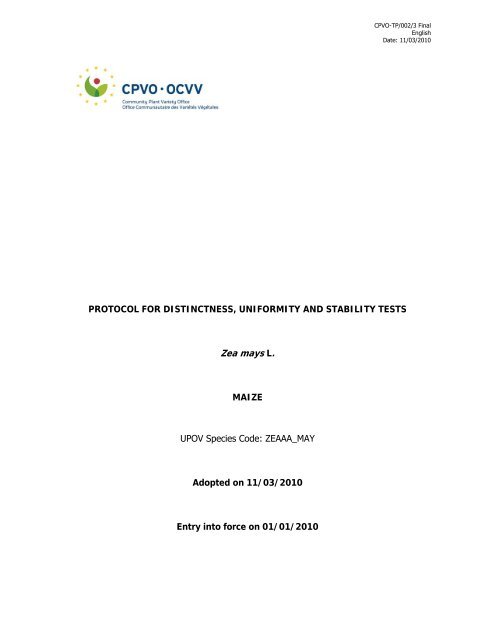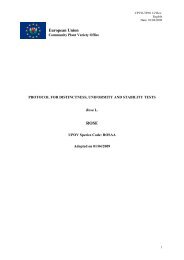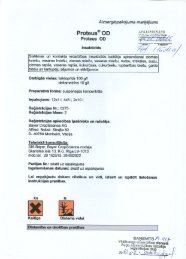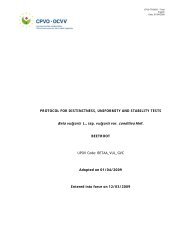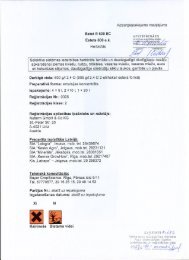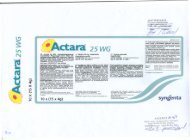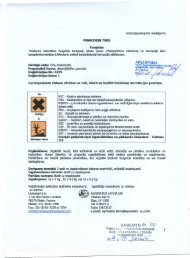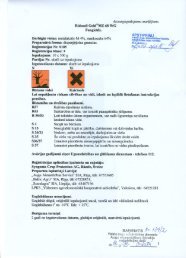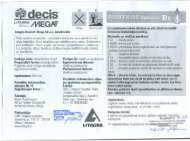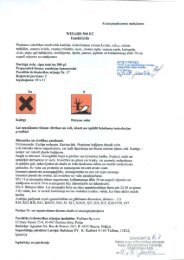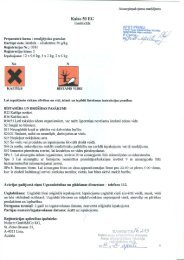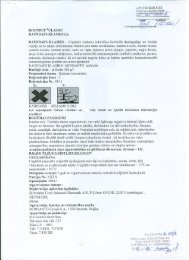Zea mays L. - VAAD
Zea mays L. - VAAD
Zea mays L. - VAAD
- No tags were found...
Create successful ePaper yourself
Turn your PDF publications into a flip-book with our unique Google optimized e-Paper software.
CPVO-TP/002/3 FinalEnglishDate: 11/03/2010PROTOCOL FOR DISTINCTNESS, UNIFORMITY AND STABILITY TESTS<strong>Zea</strong> <strong>mays</strong> L.MAIZEUPOV Species Code: ZEAAA_MAYAdopted on 11/03/2010Entry into force on 01/01/2010
CPVO-TP/002/3 FinalEnglishDate: 11/03/2010ISUBJECT OF THE PROTOCOLThe protocol describes the technical procedures to be followed in order to meet the Council Regulation 2100/94 onCommunity Plant Variety Rights. The technical procedures have been agreed by the Administrative Council and arebased on general UPOV document TG/1/3 and UPOV Guideline TG/2/7 dated 1 April 2009 for the conduct of testsfor Distinctness, Uniformity and Stability. This protocol applies to all varieties of <strong>Zea</strong> <strong>mays</strong> L., excluding ornamentalvarieties.IISUBMISSION OF SEED AND OTHER PLANT MATERIAL1. The Community Plant Variety Office (CPVO) is responsible for informing the applicant of:• the closing date for the receipt of plant material;• the minimum amount and quality of plant material required;• the examination office to which material is to be sent.A sub-sample of the material submitted for test will be held in the reference collection as the definitive sample ofthe candidate variety.The applicant is responsible for ensuring compliance with any customs and plant health requirements.2. Final dates for receipt of documentation and material by the Examination OfficeThe final dates for receipt of requests, technical questionnaires and the final date or submission period for plantmaterial will be decided by the CPVO and each Examination Office chosen (hereunder point 3).The Examination Office is responsible for immediately acknowledging the receipt of requests for testing, andtechnical questionnaires. Immediately after the closing date for the receipt of plant material the Examination Officeshould inform the CPVO if no plant material has been received. However if unsatisfactory plant material is submittedthe CPVO should be informed as soon as possible.3. Seed requirementThe final dates for request for technical examination and sending of Technical Questionnaire as well assubmission date of plant material by the applicant, and quantity of plant material to be supplied by theapplicant are published on the CPVO website and in the S2 official gazette.Quality of seed: ......................... The minimum requirements for germination capacity and analytical purityshould not be less than the standards laid down for certified seed in CouncilDirective 66/402/EEC for maize and in Annex II of Council Directive2002/55/EC for sweet corn and pop corn.Seed Treatment ........................... The plant material must not have undergone any treatment unless the CPVO andthe examination office allow or request such treatment. If it has been treated,full details of treatment must be given.Special requirements: ................... -Labelling of sample: ..................... - Species- File number of the application allocated by the CPVO- Breeder's reference- Examination reference (if known)- Name of applicant- The phrase “On request of CPVO”2
CPVO-TP/002/3 FinalEnglishDate: 11/03/2010IIICONDUCT OF TESTS1. Variety collectionA variety collection will be maintained for the purpose of establishing distinctness of the candidate varieties in test. Avariety collection may contain both living material and descriptive information. A variety will be included in a varietycollection only if plant material is available to make a technical examination.Pursuant to Article 7 of Council Regulation (EC) No. 2100/94, the basis for a collection should be the following:• varieties listed or protected at the EU level or at least in one of the EEA Member States;• varieties protected in other UPOV Member States;• any other variety in common knowledge.• in the case of hybrids, all components of hybrid varieties in common knowledge must be considered as partof the variety collection.The composition of the variety collection in each Examination Office depends on the ecological conditions in which theExamination Office is located.Variety collections will be held under conditions which ensure the long term maintenance of each accession. It is theresponsibility of Examination Offices to replace reference material which has deteriorated or become depleted.Replacement material can only be introduced if appropriate tests confirm conformity with the existing referencematerial. If any difficulties arise for the replacement of reference material Examination Offices must inform the CPVO.If authentic plant material of a variety cannot be supplied to an Examination Office the variety will be removed fromthe variety collection.2. Material to be examinedCandidate varieties will be directly compared with other candidates for Community plant variety rights tested at thesame Examination Office, and with appropriate varieties in the reference collection. When necessary an ExaminationOffice may also include other candidates and varieties. Examination Offices should therefore make efforts to coordinatetheir work with other offices involved in DUS testing of maize. There should be at least an exchange oftechnical questionnaires for each candidate variety, and during the test period, Examination Offices should notify eachother and the CPVO of candidate varieties which are likely to present problems in establishing distinctness. In order tosolve particular problems Examination Offices may exchange plant material.3. Characteristics to be usedThe characteristics to be used in DUS tests and preparation of descriptions shall be those referred to in the Annex 1.All the characteristics shall be used, providing that observation of a characteristic is not rendered impossible by theexpression of any other characteristic, or the expression of a characteristic is prevented by the environmentalconditions under which the test is conducted. In the latter case, the CPVO should be informed. In addition, theexistence of some other regulation e.g. plant health, may make the observation of the characteristic impossible.In cases where the distinction of hybrid varieties is based on the distinction of parental lines, the description of thehybrid must at least include those characteristics of Annex 1 which are indicated by an H.The list of characteristics derived from enzyme electrophoresis as in Annex 2 should only be used as a complement toother differences in morphological or physiological characteristics.The Administrative Council empowers the President, in accordance with Article 23 of Commission Regulation (EC)No.874/2009, to insert additional characteristics and their expressions in respect of a variety.3
CPVO-TP/002/3 FinalEnglishDate: 11/03/20104. Grouping of varietiesThe varieties and candidates to be compared will be divided into groups to facilitate the assessment of distinctness.Characteristics which are suitable for grouping purposes are those which are known from experience not to vary, or tovary only slightly, within a variety and which in their various states of expression are fairly evenly distributedthroughout the collection. In the case of continuous grouping characteristics overlapping states of expression betweenadjacent groups is required to reduce the risks of incorrect allocation of candidates to groups. The characteristics thatcould be used for grouping are the following (CPVO numbering; G for grouping in the table of characteristics):a) Tassel: time of anthesis (characteristic 6)b) Tassel: anthocyanin coloration at base of glume (characteristic 7)c) Ear: anthocyanin coloration of silks (characteristic 14)d) Plant: length (characteristic 22)e) Ear: type of grain (characteristic 34)f) Excluding varieties with ear type of grain: sweet: Ear: colour of dorsal side of grain (characteristic 37)g) Ear: anthocyanin coloration of glumes of cob (characteristic 39)5. Trial designs and growing conditionsThe minimum duration of tests will normally be two independent growing cycles. Tests will be carried out underconditions ensuring normal growth. The size of the plots will be such that plants or parts of plants may be removedfor measuring and counting without prejudice to the observations which must be made up to the end of the growingcycle.The test design is a s follows:As a minimum, each test should include a total of 40 plants in the case of inbred lines and single hybrids and 60plants in the case of other hybrids and open-pollinated varieties, divided between two or more replicates.Number of Plants / Parts of Plants to be ExaminedInbred lines and single hybrids: All observations on single plants (MS) should be made on 10 plants or partstaken from each of 10 plants and all other observations made on all plants in the test.Other types of hybrids: All observations on single plants (MS) should be made on 20 plants or parts taken fromeach of 20 plants and all other observations made on all plants in the test.Open-pollinated varieties: All observations on single plants (MS) should be made on 40 plants or parts taken fromeach of 40 plants and all other observations made on all plants in the test.6. Special testsIn accordance with Article 83(3) of Council Regulation (EC) No. 2100/94 an applicant may claim either in theTechnical Questionnaire or during the test that a candidate has a characteristic which would be helpful in establishingdistinctness. If such a claim is made and is supported by reliable technical data, a special test may be undertakenproviding that a technically acceptable test procedure can be devised.Special tests will be undertaken, with the agreement of the President of CPVO, where distinctness is unlikely to beshown using the characters listed in the protocol.4
CPVO-TP/002/3 FinalEnglishDate: 11/03/20107. Standards for decisionsa) DistinctnessA candidate variety will be considered to be distinct if it meets the requirements of Article 7 of Council Regulation (EC)No. 2100/94.To assess distinctness of hybrids, a pre-screening system on the basis of the parental lines and the formula maybe established according to the following recommendations:(i) description of parental lines according to the Test Guidelines;(ii) check of the originality of the parental lines in comparison with the reference collection, based on thecharacteristics in Annex 1 in order to screen the closest inbred lines;(iii) check of the originality of the hybrid formula in comparison with those of the hybrids in commonknowledge, taking into account the closest inbred lines;(iv) assessment of the distinctness at the hybrid level of varieties with a similar formula.Qualitative characteristics:In the case of characteristics which show discrete discontinuous states of expression, a difference between twovarieties is clear if one or more of the respective characteristics have expressions which fall into two different states.Quantitative characteristics:Characteristics which show a continuous range of expression from one extreme to the other may be either measuredor visually observed.In the case of visually observed characteristics, a difference between two varieties is clear if the expression of therespective characteristics differs by at least the span of one note, taking into account the variability observed withinthe varieties.If distinctness is assessed by the combined over years distinctness analysis (COYD) the difference between twovarieties is clear if the respective characteristics are different at the 1% significance level or less (p
CPVO-TP/002/3 FinalEnglishDate: 11/03/2010If ear-rows are also used, a population standard of 3 % with an acceptance probability of 95 % should be applied.The candidate is considered to be sufficiently uniform if the number of off-type ear- rows does not exceed 1 in 6 earrowsexamined. For sown plots the above-mentioned population standard is applicable. By analogy this provision alsoapplies to any plant progeny test.With respect to the use of enzyme electrophoresis, the Office follows the actual UPOV approach as laid down inpart I of Annex 2 hereto. If enzyme electrophoresis is used for testing distinctness, the same population standardand the same acceptance probability as for other characteristics should be applied. However, a sequentialanalysis approach could be applied to reduce the workload. Any plant in an inbred line should be considered asan out-cross where two or more loci are heterozygous with one allele of the locus of the inbred line (e.g. AX). Allcases where one locus is heterozygous or where two foreign alleles are present at least one locus should beconsidered off-types.c) StabilityA candidate will be considered to be sufficiently stable when there is no evidence to indicate that it lacks uniformity.Seed samples of further submissions included in any test must show the same expression of characteristics as thematerial originally supplied.IVREPORTING OF RESULTSAfter each recording season the results will be summarised and reported to the CPVO in the form of a UPOV modelinterim report in which any problems will be indicated under the headings distinctness, uniformity and stability.Candidates may meet the DUS standards after two growing cycles but in some cases three growing cycles may berequired. When tests are completed the results will be sent by the Examination Office to the CPVO in the form of aUPOV model final report.If it is considered that the candidate complies with the DUS standards, the final report will be accompanied by avariety description in the format recommended by UPOV. If not the reasons for failure and a summary of the testresults will be included with the final report.The CPVO must receive interim reports and final reports by the date agreed between the CPVO and the examinationoffice.Interim reports and final examination reports shall be signed by the responsible member of the staff of theExamination Office and shall expressly acknowledge the exclusive rights of disposal of CPVO.VLIAISON WITH THE APPLICANTIf problems arise during the course of the test the CPVO should be informed so that the information can be passed onto the applicant. Subject to prior permanent agreement, the applicant may be directly informed at the same time asthe CPVO particularly if a visit to the trial is advisable.The annual interim report as well as the final report shall be sent by the Examination Office to the CPVO.6
CPVO-TP/002/3 FinalEnglishDate: 11/03/2010VIENTRY INTO FORCEThe present protocol enters into force on 01/01/2010. Any ongoing DUS examination of candidate varieties startedbefore the aforesaid date will not be affected by the approval of the revised Technical Protocol.Technical examinations of candidate varieties are carried out according to the TP in force when the DUS test starts.The starting date of a DUS examination is considered to be the due date for submitting of plant material for the firsttest period.In cases where the Office requests to take-over a DUS report for which the technical examination has either beenfinalized or which is in the process to be carried out at the moment of this request, such report can only be acceptedif the technical examination has been carried out according to the CPVO TP which was in force at the moment whenthe technical examination started.**********7
CPVO-TP/002/3 FinalEnglishDate: 11/03/2010ANNEXES TO FOLLOWANNEX IPAGETable of characteristics to be used in DUS-test and preparation of descriptions ................................ 9Explanations and methods ........................................................................................................... 19Legend:(+) See explanations on the table of characteristics(a)-(e) See explanations on the table of characteristicsH Characteristics to be included into the description of a hybrid as a minimumG Grouping characteristic(S) Possible segregation in three-way and double-cross hybrid varietiesPC Popcorn varietySC Sweet corn variety14-93 Decimal Code for the Growth StagesTypes of expression of characteristics:QLQNPQQualitative characteristicQuantitative characteristicPseudo-qualitative characteristicType of observation of characteristics:MGMSVGVSSingle measurement of a group of plants or parts of plantsMeasurement of a number of individual plants or parts of plantsVisual assessment by a single observation of a group of plants or parts of plantsVisual assessment by observation of individual plants or parts of plantsWhen a method of observation is attributed to a certain characteristic, the first differentiation is made depending if theaction taken is a visual observation (V) or a measurement (M).The second differentiation deals with the number of observations the expert attributes to each variety, thus theattribution of either G or S.If a single observation of a group consisting of an undefined number of individual plants is appropriate to assess theexpression of a variety, we talk about a visual observation or a measurement made on a group of plants, thus weattribute the letter G (either VG or MG). If the expert makes more than one observation on that group of plants, thedecisive part is that we have at the end only one data entry per variety which means that we have to deal with G (e.g.measurement of plant length on a plot – MG, visual observation of green colour of leaves on a plot – VG).If it is necessary to observe a number of individual plants to assess the expression of a variety, we should attribute theletter S (thus either VS or MS). Single plant data entries are kept per variety for further calculations like the variety mean(e.g. measurement of length of ears – MS, visual observation of growth habit of single plants in grasses – VS). Thenumber of individual plants to be observed in such cases is stated in section III.5.ANNEX IIProtein Electrophoresis ................................................................................................................. 26Literature .................................................................................................................................... 43ANNEX IIITechnical Questionnaire8
CPVO-TP/002/3 FinalEnglishDate: 11/03/2010ANNEX ITABLE OF CHARACTERISTICS TO BE USED IN DUS-TEST AND PREPARATION OF DESCRIPTIONSCPVON°UPOVN°Stage 1 Characteristics Examples Note1. 1. VG First leaf: anthocyanin coloration of sheathQN 14 absent or very weak 0674, Jubilee (SC) 1(S) weak MO17, Puma (SC) 3medium F252, Gyöngymazsola (SC) 5strong F244 7very strong 92. 2. VG First leaf: shape of apex(+) 14 pointed 1PQ pointed to rounded 0674 2rounded Empire (SC), F816 3rounded to spatulate F259, Merkur (SC) 4spatulate EP1 53. 3. VG Foliage: intensity of green colourQN 51-59 light W182E 1medium W117, Empire (SC) 2dark GSS 3287 (SC), W401 34. 5. VG Leaf: angle between blade and stem(+) 65-69 very small 1QN (a) small A188 3H medium F66, GH2547 (SC) 5large F186, Spirit (SC) 7very large 91The optimum stage of development for the assessment of each characteristic is indicated by a number in the second column. Thestages of development denoted by each number are described in the Decimal Code for the growth stages (page 25).9
CPVO-TP/002/3 FinalEnglishDate: 11/03/2010CPVON°UPOVN°Stage 1 Characteristics Examples Note5. 6. VG Leaf: curvature of blade(+) 65-69 absent or very slightly recurved WD36 1QN (a) slightly recurved A654, Bonus (SC) 3H moderately recurved W117, Jubilee (SC) 56. 8. MG Tassel: time of anthesisstrongly recurved W79A 7very strongly recurved 9(+) * (b) very early 1QN very early to early KW1069, Spirit (SC) 2H early F257, Champ (SC) 3early to medium F259, Centurion (SC) 4medium F522, Zenith (SC) 5medium to late A632 6late B73 7late to very late AM1513 8G very late 97. 9. VG Tassel: anthocyanin coloration at base ofglume(+) * 65-69 absent or very weak W117, Royalty (SC) 1QN (S) weak F66, Boston (SC) 3H (b) medium F107 5strong EP1 7G very strong 98. 10. VG Tassel: anthocyanin coloration of glumesexcluding base(+) 65-69 absent or very weak F259, Empire (SC) 1QN (S) weak F2, Royalty (SC) 3H (b) medium WD36, Centurion (SC) 5strong W79A 7very strong 910
CPVO-TP/002/3 FinalEnglishDate: 11/03/2010CPVON°UPOVN°Stage 1 Characteristics Examples Note9. 11. VG Tassel: anthocyanin coloration of anthers(+) (S) absent or very weak A654, Empire (SC) 1QN (b) weak F2, Royalty (SC) 3H medium W182E, Centurion (SC) 5strong 7very strong 910. 12. VG Tassel: angle between main axis andlateral branches(+) * 65-69 very small 1QN (c) small F492 3H medium EP1, Mv. Aranyos (SC) 5large F186, Bonus (SC) 7very large 911. 13. VG Tassel: curvature of lateral branches(+) * 69 absent or very slightly recurved F257, El Toro (SC) 1QN (S) slightly recurved F816, Empire (SC) 3H (c) moderately recurved W182E, Bonus (SC) 5strongly recurved F66 7very strongly recurved 912. 14. MS/VG Tassel: number of primary lateral branchesQN * 65-75 absent or very few F7 1H few F252, Mv. Aranyos (SC) 3medium F244, Kokanee (SC) 5many A188, Zenith (SC) 7very many Suregold (SC) 911
CPVO-TP/002/3 FinalEnglishDate: 11/03/2010CPVON°UPOVN°Stage 1 Characteristics Examples Note13. 15. MG Ear: time of silk emergence(+) very early Mv. Aranyos (SC) 1QN very early to early KW1069, Spirit (SC) 2H early F257, Champ (SC) 3early to medium F259, Royalty (SC) 4medium F522, Bonus (SC) 5medium to late A632 6late B73 7late to very late AM1513 8very late 914. 16. VG Ear: anthocyanin coloration of silks 1QN * 65 absent or very weak F7, F195, Bonus (SC) 1H (S) weak F257, El Toro (SC) 3medium F244, Gyöngymazsola (SC) 5strong W401 7G very strong 915. 17. VG Stem: anthocyanin coloration of braceroots(+) 61 - 79 absent or very weak F16, Jubilee (SC) 1QN (S) weak W117, Puma (SC) 3H medium WD36, El Toro (SC) 516. 18. VG Tassel: density of spikeletsstrong EP1 7very strong 9QN 61-71 moderately lax F16 3(b) medium EP1, Royalty (SC) 5moderately dense F259, Empire (SC) 712
CPVO-TP/002/3 FinalEnglishDate: 11/03/2010CPVON°UPOVN°Stage 1 Characteristics Examples Note17. 19. VG Leaf: anthocyanin coloration of sheath(+) 71-75 absent or very weak W401, Jubilee (SC) 1QN (S) weak F107 3medium F257 5strong EP1 7very strong 918. 20. VG Stem: anthocyanin coloration of internodes(+) 71-75 absent or very weak F259, Jubilee (SC) 1QN (S) weak F816 3medium W79A 5strong F257 7very strong 919. 21. MS Tassel: length of main axis above lowestlateral branch(+) 71-75 very short 1QN short EP1 3medium F244, Bonus (SC° 5long F492, Empire (SC) 7very long 920. 22. MS Tassel: length of main axis above highestlateral branch(+) * 71-75 very short 1QN short EP1 3H medium W182E 5long F492 7very long 913
CPVO-TP/002/3 FinalEnglishDate: 11/03/2010CPVON°UPOVN°Stage 1 Characteristics Examples Note21. 23. MS Tassel: length of lateral branchQN 71-75 very short 1(c) short EP1 3medium A632 5long F492 7very long 922.1. 24.1 MS Only inbred lines and varieties with eartype of grain: sweet or pop: Plant: length(+) * 75-85 very short F7 1QN short W117, Spirit (SC) 3medium F244, Puma (SC) 5long WD36, Royalty (SC) 7G very long Enterprise (SC) 922.2 24.2 MS Only hybrids and open-pollinated varieties,excluding varieties with ear type of grain:sweet or pop: Plant: length(+) * 75-85 very short 1QN short PR39D23 3H medium PR37Y12 5long DKC5166 7G very long 923. 25. MG Plant: ratio height of insertion of peduncleof upper ear to plant length(+) 75-85 very small Gyöngymazsola (SC) 1QN small F816, Spirit (SC) 3H medium F252, Royalty (SC) 5large F481 7very large 914
CPVO-TP/002/3 FinalEnglishDate: 11/03/2010CPVON°UPOVN°Stage 1 Characteristics Examples Note24. 26 MS Leaf: width of bladeQN 75-85 very narrow 1(a) narrow F16, Champ (SC) 3medium F244, Empire (SC) 5wide F481, Centurion (SC) 7very wide 925. 27. VG Peduncle: lengthQN 75-85 very short 1short F259, Centurion (SC) 3medium A654, Jubilee (SC) 5long F107 7very long 926. 28. MS Ear: length(+) * 92-93 very short 1QNsweetcorn:short F2 3H 75-79 medium A654, Spirit (SC) 5long MO17, Empire (SC) 7very long 927. 29. MS Ear: diameter (in middle)QN 92-93 very small 1Hsweetcorn:small F7 375-79 medium W117 5large F481, Centurion (SC) 7very large Empire (SC) 915
CPVO-TP/002/3 FinalEnglishDate: 11/03/2010CPVON°UPOVN°Stage 1 Characteristics Examples Note28. 30. VG Ear: shape(+) 92-93 conical F16, Wombat (SC) 1QNsweetcorn:conico-cylindrical F816, Centurion (SC) 275-79 cylindrical F66, GH2547 (SC) 329. 31. MS Ear: number of rows of grainQN QN 92-93 very few 1Hsweetcorn:few F257 375-93 medium F16, Dessert 73 (SC) 5many B73, Bonus (SC) 7very many 930.(+)32. VG Only varieties with ear type of grain: sweetor waxy: Ear: number of colours of grainsQL 75-79(S)one Jubilee (SC) 1H (e) two Eolrukchal-ilho, Serendipity (SC) 231. 33. VG Only varieties with ear type of grain:sweet: Grain: intensity of yellow colourQN * 75-79 light Gyöngymazsola (SC) 3H (e) medium Royalty (SC) 5dark Kokanee (SC) 732. 34. VG Only varieties with ear type of grain:sweet: Grain: lengthQN 75-79 short 3H (d) medium Boston (SC) 5long GH5704 (SC) 733. 35. VG Only varieties with ear type of grain:sweet: Grain: width(+) 75-79 narrow Bonus (SC) 3QN (d) medium Jubilee (SC) 5H broad Mv. Aranyos (SC) 716
CPVO-TP/002/3 FinalEnglishDate: 11/03/2010CPVON°UPOVN°Stage 1 Characteristics Examples Note34. 36. VG Ear: type of grain(+) * 92-93(S)flint F2 1QL (d) flint-like F252 2H (e) intermediate F107 3dent-like A654 4dent W182E 5sweet Jubilee (SC) 6pop Iowa Pop (SC) 7waxy 8G flour 935. 37. VG Only varieties with ear type of grain:sweet: Ear: shrinkage of top of grain(+) * 92-93 weak Zarja (SC) 1QN (d) medium Merkur (SC) 3H (e) strong Dessert 73 (SC) 536. 38. VG Ear: colour of top of grainPQ * 92-93 white A188, Purple white (SC),Snowbelle (SC)1H (S) yellowish white 2(d) yellow F259 3(e) yellow orange F2, Gyöngymazsola (SC) 4orange F257, GH2547 (SC) 5red orange Dynasty (SC) 6red 7purple 8brownish Zenith (SC) 9blue black Miheukchal 1017
CPVO-TP/002/3 FinalEnglishDate: 11/03/2010CPVON°UPOVN°Stage 1 Characteristics Examples Note37. 39. VG Excluding varieties with ear type of grain:sweet: Ear: colour of dorsal side of grainPQ * 92-93 white F481 1H (S) yellowish white A188 2(d) yellow 3(e) yellow orange F66 4orange EP1 5red orange 6red 7purple 8brownish 9G blue black 1038. 40. VG Only varieties with ear type of grain: pop:Type of popped grain(+) 93 butterfly Robust 97461 (PC) 1QN intermediate 2H globular Robust 90252 (PC) 339. 41. VG Ear: anthocyanin coloration of glumes ofcob(+) * 93 absent or very weak F2, F257 1QN (S) weak F252 3H medium W117 5strong A632 7G very strong 918
CPVO-TP/002/3 FinalEnglishDate: 11/03/2010EXPLANATIONS AND METHODS1 Explanations covering several characteristicsCharacteristics containing the following key in the second column of the Table of Characteristics should be examined asindicated below:(a)(b)(c)(d)(e)The observation should be made on the leaf just above upper ear.The observation should be made in the middle third of the main branch of the tassel.The observation should be made on the second branch from the bottom of the tassel.The observation should be made in the middle third of the uppermost ear, when well developed.This characteristic may be influenced by cross-pollination. In particular in sweet corn and popcornvarieties, cross-pollination should be avoided.2 Explanations for individual characteristicsAd. 2: First leaf: shape of apex1 2 3 4 5pointed pointed to rounded rounded round to spatulate spatulateAd. 4: Leaf: angle between blade and stemAd. 10: Tassel: angle between main axis and lateral branches1 3 5 7 9very small(< 5°)small(+ 25°)medium(+ 50°)large(+ 75°)very large(> 90°)19
CPVO-TP/002/3 FinalEnglishDate: 11/03/2010Ad. 5: Leaf: curvature of bladeAd. 11: Tassel: curvature of lateral branches1 3 5 7 9absent or verymoderatelyslightly recurvedstrongly recurved very strongly recurvedslightly recurvedrecurvedAd. 6: Tassel: time of anthesisThe time of anthesis is when 50% of plants have anthers visible in the middle third of the main branch.Ad. 7: Tassel: anthocyanin coloration at base of glumeAd. 8: Tassel: anthocyanin coloration of glumes excluding basebase of glumeAd. 9: Tassel: anthocyanin coloration of anthersThe observation should be made in the middle third of the main branch on fresh anthers.Ad. 13: Ear: time of silk emergenceThe time of silk emergence is the time when silks have emerged on 50% of plants.Ad. 15: Stem: anthocyanin coloration of brace rootsThe observation should be made when well developed and fresh brace roots are present on 50% of plants.Ad. 17: Leaf: anthocyanin coloration of sheathThe observation should be made in the middle third of the plant.20
CPVO-TP/002/3 FinalEnglishDate: 11/03/2010Ad. 18: Stem: anthocyanin coloration of internodesThe observation should be made just above insertion point of peduncle of upper ear.Ad. 19: Tassel: length of main axis above lowest lateral branchAd. 20: Tassel: length of main axis above highest lateral branchAd. 22Ad. 21Ad. 22.1: Only inbred lines and varieties with ear type of grain: sweet or pop: Plant: lengthAd. 22.2: Only hybrids and open-pollinated varieties, excluding varieties with ear type of grain: sweet or pop: Plant:lengthAd. 23: Plant: ratio height of insertion of peduncle of upper ear to plant lengthThe plant length should be observed including the tassel.Ad. 26: Ear: lengthAd. 28: Ear: shape1 2 3conical conico-cylindrical cylindrical21
CPVO-TP/002/3 FinalEnglishDate: 11/03/2010Ad. 30: Only varieties with ear type of grain: sweet or waxy: Ear: number of colours of grains1 2onetwoBicolour varieties have yellow and white grains on their ears. Cross pollination should be avoided particularly betweenwhite, bicolour and yellow grain coloured varieties.Ad. 33: Only varieties with ear type of grain: sweet: Grain: widthAd. 34: Ear: type of grain1 2 3 4 5 6 7flint flint-like intermediate dent-like dent sweet pop22
CPVO-TP/002/3 FinalEnglishDate: 11/03/20101 flint mostly hard endosperm, round grain, thick layer of hard endosperm on crown, largergrains than pop2 flint-like mostly hard endosperm, round grain, intermediate layer of hard endosperm oncrown3 intermediate thin layer of hard endosperm on crown, crown slightly indented4 dent-like mostly soft endosperm, crown moderately indented, medium layer of hardendosperm on dorsal side of grain,5 dent mostly soft endosperm covering also exterior part of crown, thin layer of hardendosperm only on dorsal side of grain, grain strongly indented on crown6 sweet glassy endosperm with very low or no starch content, wrinkled grain7 pop nearly completely hard endosperm, rice-type (pointed grain) or pearl type (roundedgrain), very thick layer of hard endosperm on crown, smaller grains than flint8 waxy approximately 100 % amylopectine, waxy appearance of grain, pink coloration ofendosperm in iodine staining test (blue black coloration of other types of grain).Iodine staining testwaxynon waxy9 flour completely soft endosperm, grain round or slightly indented on crownAd. 35: Only varieties with ear type of grain: sweet: Ear: shrinkage of top of grain1 3 5weak medium strongIn order to obtain uniform expressions of the grains on the ear, cross pollination between varieties should be avoided,e.g. by a special trial design. Cross pollination can cause irregular expressions of the grains and may lead to a wronginterpretation that the variety is not uniform.23
CPVO-TP/002/3 FinalEnglishDate: 11/03/2010Ad. 38: Only varieties with ear type of grain: pop: Type of popped grainEar should be stored for a minimum of 2 or 3 months after harvest before popping.The dry grains (13-13.5% water content is optimal) are popped with heating. The typical shape of the popped grainshas to be observed.1 3butterflyglobularAd. 39: Ear: anthocyanin coloration of glumes of cobThe anthocyanin coloration should be observed on the middle third of the uppermost cob, after the removal of some ofthe grains.3 Decimal Code for the Growth Stages*CODEGENERAL DESCRIPTIONSeedling growth14 4 leaves unfoldedTilleringStem elongationBootingInflorescence emergence51 Inflorescence just visible59 Emergence of inflorescence completedAnthesis61 Beginning of anthesis65 Anthesis halfway69 Anthesis completeMilk development71 Caryopsis watery ripe24
CPVO-TP/002/3 FinalEnglishDate: 11/03/2010CODEGENERAL DESCRIPTION73 Early milk75 Medium milk79 (1) Grains have reached final sizeDough development85 Soft doughRipening92 Caryopsis hard (can no longer be dented y thumbnail)93 Caryopsis loosening in daytime* Extracted from J.C. Zadoks, T.T. Chang and C.F. Konzak except (1), Decimal Code for the Growth States of Cereals,EUCARPIA Bulletin No. 7, 1974, pp. 42-52.25
CPVO-TP/002/3 FinalEnglishDate: 11/03/2010ANNEX IIPROTEIN ELECTROPHORESISAdditional Useful ExplanationsTABLE OF CONTENTSPart I. Introduction .............................................................................................. Page 27Part II. Characteristics Derived by Isozyme Polymorphism ......................................... Page 28Part III. Description of the SGE Method for the ......................................................... Page 31Analysis of Isozymes from <strong>Zea</strong> <strong>mays</strong> L.Description of the example inbred lines ............................................................................. Page 4226
CPVO-TP/002/3 FinalEnglishDate: 11/03/2010Part IIntroductionThe following Annex contains a list of characteristics derived by using protein electrophoresis and a description of themethod to be used. UPOV decided to place these characteristics in an Annex to the Test Guidelines, thereby creating aspecial category of characteristic, because the majority of the UPOV member States is of the view that it is not possibleto establish distinctness solely on the basis of a difference found in a characteristic derived by using electrophoresis.Such characteristics should therefore only be used as a complement to other differences in morphological orphysiological characteristics. UPOV reconfirms that these characteristics are considered useful but that they might not besufficient on their own to establish distinctness. They should not be used as a routine characteristic but at the request orwith the agreement of the applicant of the candidate variety.For the analysis of isozymes, starch gel electrophoresis is recommended. Polymorphism of isozymes (i.e. 16 enzyme loci)can be detected. Genetic control is known for each enzyme locus. For the description of the method and the geneticinterpretation of the zymograms, reference is made to the technical bulletin by Stuber, Wendel, Goodman and Smith,1988, and the technical handbook by Grenèche and Giraud, 1994. The alleles are described by band numbers accordingto the definition given by Cardy, Stuber, Goodman, 1980, (see Chapter IX, Literature).27
CPVO-TP/002/3 FinalEnglishDate: 11/03/2010Part IICharacteristics derived by Isozyme PolymorphismCharacteristics Examples Note40.QLAllele expression atlocus Mdh 1Genotype 1/1Genotype 0.5/0.5Genotype 0.5/1Genotype 1/6 in interaction with allele 6of Mdh 2Genotype 0.5/6 in interaction with allele6 of Mdh 2F252R3126KW 5361 xKW 5454TauClarica1Genotype 6/6 A239 2Genotype 1/6 but not in interaction withallele 6 of Mdh 2Genotype 0.5/6 but not in interactionwith allele 6 of Mdh 2MarshallDK231341.QLAllele expression atlocus Mdh 2Genotype 3/3Genotype 3.5/3.5Genotype 3/3.5Genotype 3/4.5Genotype 3.5/4.5F252R3126Limit, DK 231Robin1Genotype 4.5/4.5 W401 2Genotype 6/6 A239 3Genotype 3/6Genotype 3.5/6AzurClarica4Genotype 4.5/6 542. Allele expression atlocus Mdh 3 Genotype 16/16 F252 1QL Genotype 18/18 CO 158 2Genotype 16/18 Figaro 343. Allele expression atlocus MmmGenotype M/MGenotype M/mF252 1QL Genotype m/m 86 N 42 244. Allele expression at lociMdh 4 + Mdh 5 Genotype 12/12 +12/12 F252 1QL Genotype 12/12 + 15/15Genotype 12/12 + 12/15F 2Robin228
CPVO-TP/002/3 FinalEnglishDate: 11/03/2010Characteristics Examples Note45. Allele expression at lociIdh1 + Idh 2Genotype 4/4 + 4/4Genotype 4/6 + 4/4A239 1QL Genotype 4/4 + 6/6 CM7 2Genotype 6/6 + 4/4 F1110 3Genotype 6/6 + 6/6Genotype 4/6 + 6/6Genotype 4/4 + 4/6Genotype 4/6 + 4/6CO 158BonnyAxonLoft45Genotyp 6/6 + 4/6 646. Allele expression at lociPgd 1 + Pgd2 Genotype 2/2 + 5/5 W401 1QL Genotype 2/2 + 2.8/2.8Genotype 2/2 + n/nGenotype 3.8/3.8 + 2.8/2.8Genotype 3.8/3.8 +n/nSK 203 2A632 3Genotype 3.8/3.8 + 5/5Genotype 3.8/3.8 + 2.8/5Genotype n/3.8 + 5/5F252Tekila4Genotype n/n + 5/5 H108 5Genotype 2/3.8 + 5/5Genotype 2/3.8 + 2.8/5BekefixFurio6Genotype 2/2 + 2.8/5 NX 6032 747. Allele expression at lociPgm 1 + Pgm2 Genotype 9/9 + 1/1 F 2 1PQ Genotype 9/9 + 1/3 Robin 2Genotype 9/9 + 3/3 F 16 3Genotype 9/9 + 3/4 Figaro 4Genotype 9/9 + 4/4 A 632 5Genotype 9/9 + 1/4 Axon 6Genotype 9/9 + 8/8 MO 17 7Genotype 9/9 + 3/8 8Genotype 9/9 + 4/8 Occitan 9Genotype 9/9 + 1/8 10Genotype 16/16 + 1/1 11Genotype 16/16 + 1/3 12Genotype 16/16 + 3/3 9034 13Genotype 16/16 + 4/4 14Genotype 16/16 + 8/8 F 492 15Genotype 5/5+3/3 D 06 1629
CPVO-TP/002/3 FinalEnglishDate: 11/03/2010Characteristics Examples Note48. Allele expression atlocus Pgi 1 Genotype 4/4 A239 1QL Genotype 5/5 A632 2Genotype 4/5 Artist 349. Allele expression atlocus Acp1 Genotype 2/2 F 2 1PQ Genotype 2/3 Azur 2Genotype 3/3 A 239 3Genotype 4/6 Contessa 4Genotype 4/4 A 632 5Genotype 6/6 F 1444 6Genotype 2/4 Occitan 7Genotype 2/6 8Genotype 3/4 Marshall 9Genotype 3/6 1050. Allele expression atlocus Dia 1 Genotype 8/8 F 2 1QL Genotype 12/12 CO 158 2Genotype 8/12 Bastion 351. Allele expression atlocus Dia2 Genotype 4/4 F 2 1QL Genotype 6/6 34 M 838 2Genotype 4/6 31 N 6 352. Allele expression atlocus Adh 1 Genotype 4/4 F 1444 1QL Genotype 6/6 F 2 2Genotype 4/6 Bristol 330
CPVO-TP/002/3 FinalEnglishDate: 11/03/2010Part IIIDescription of the SGE Method for theAnalysis of Isozymes from <strong>Zea</strong> <strong>mays</strong> L.1. Number of coleoptiles per test- for checking formula: at least 20 coleoptiles of each inbred line2 coleoptiles of single-cross hybrids6 coleoptiles of three-way cross hybrids- for distinctness, uniformity and stability test: at least 20 coleoptiles for inbredlines, hybrids and open-pollinated varieties.2. Apparatus and equipmentAny suitable horizontal electrophoresis system can be used, provided that the gels can be kept at 4°C. A gelthickness of 10 mm is recommended. The power supply used should be capable of delivering constant voltageoutput.3. ChemicalsAll chemicals should be of 'Analytical Reagent' grade or better.3.1 Chemicals for enzyme extractionL-Ascorbic acidL-Ascorbic acid Na saltSucrose3.2 Chemicals for electrophoresisBromophenol blueCitric acid monohydrateL-HistidineStarch hydrolyzed, for electrophoresis,)3.3 Chemicals for staining enzymesAcetic acid glacial2,6-Dichlorophenol-indophenol Na saltEthanolEthylenediamine tetra-acetic acid Na2 Salt (EDTA)Fast Garnet GBC saltD-Fructose 6-phosphate Na2 saltGlucose 1-phosphate dehydrogenase (Serva 22820 or 22822 or Sigma G5885)Hydrochloric acid (HCl)DL-Isocitric acid Na3 saltMagnesium chloride hexahydrateDL-Malic acidDimethylthiazol diphenyl tetrazolium (MTT)β -Nicotinamide adenine dinucleotide (NAD)β -Nicotinamide adenine dinucleotide reduced (NADH)β -Nicotinamide adenine dinucleotide phosphate (NADP)Nitro-blue tetrazolium (NBT)Sodium hydroxide (NaOH)1-Naphtyl acid phosphate6-phosphogluconic acid Na3 salt dihydratePhenazine methosulfate (PMS)Polyvinylpyrrolidone 40 (PVP-40)Sodium acetate trihydrateTris-(hydroxymethyl) aminomethane (Tris)31
CPVO-TP/002/3 FinalEnglishDate: 11/03/20104. Solutions4.1 Extraction solution16.7 g Sucrose8.3 g sodium ascorbatemade up to 100 ml with de-ionised water and adjusted to pH 7.4 with L-ascorbic acid.4.2 Electrophoresis buffers4.2.1 Buffers for SGE pH 6.54.2.1.1 Stock solution: 0.364 M L-histidine-citrate50.44 g L-histidine8.20 g Citric acid monohydratemade up to 1 1 with de-ionised water4.2.1.2 Running buffer: 0. 072 ML-histidine-citrate pH 6.5(Stock solution diluted 1 in 5)400 ml stock solution (4.2.1.1) made up to 2 1 with de-ionised water4.2.1.3 Gel buffer: 0.024 M L-histidine-citrate(Stock solution diluted 1 in 15)80 ml stock solution (4.2.1.1) made up to 1200 ml with de-ionised water4.2.2 Buffers for SGE pH 5.04.2.2.1 Running buffer: 0.074 M L-histidine-citrate pH 5.015.5g L-histidine10.0g Citric acid monohydratemade up to 2 litres with de-ionised water4.2.2.2 Gel buffer: 0.006 M L-histidine-citrate(Running buffer diluted 1 in 12)100 ml running buffer (4.2.2.1) made up to 1200 ml with de-ionised water4.2.2.3 Bromophenol blue solution50 mg bromophenol blue dissolved in 100 ml de-ionised water4.3 Staining solutions4.3.1 Stock solutions4.3.1.1 1 M Tris-HCL pH 8.0121.1g Tris, made up to 1 liter with de-ionised water and adjusted to pH 8.0 with 50% HCl4.3.1.2 1 M Tris-HCl pH 9.1121.1 g Tris, made up to 1 liter with de-ionised water and adjusted to pH 9.1 with 50% HCl4.3.1.3 1 M Sodium acetate pH 5.0136.08 g Sodium acetate trihydrate, made up to 1 liter with de-ionised water adjusted to pH 5.0 with aceticacid glacial4.3.1.4 MTT solution1.0 g MTT made up to 100 ml with de-ionised water4.3.1.5 NBT solution1.0 g NBT made up to 100 ml with de-ionised water4.3.1.6 PMS solution200 mg PMS, made up to 100 ml with de-ionised water32
CPVO-TP/002/3 FinalEnglishDate: 11/03/20104.3.1.7 MgCl2 solution21.35 g Magnesium chloride hexahydratemade up to 100 ml with de-ionised water4.3.1.8 Malic acid solution5 g LL-Malic acid, made up to 100 ml with de-ionised water and adjusted to pH 8.0 with 1 M NaOH4.3.2 Staining solutions (volume: 200 ml)4.3.2.1 MDH + ADH staining solution20 ml Tris-HCl pH 9.1 (4.3.1.2.)+ 180 ml de-ionised water+ 8 ml Malic acid solution (4.3.1.8.)+ 10 ml Ethanol+ 80 mg NAD+ 4 ml NBT solution (4.3.1.5.)+ 3 ml PMS solution (4.3.1.6.)4.3.2.2 IDH staining solution20 ml Tris-HCl pH 8.0 (4.3.1.5.)+ 180 ml de-ionised water+ 500 mg DL-Isocitric acid Na3 salt+ 10 ml MgCl2 solution (4.3.1.7.)+ 6 mg NADP+ 4 ml MTT solution (4.3.1.4.)+ 3 ml PMS solution (4.3.1.6.)4.3.2.3 PGI + PGD staining solution20 ml Tris-HC1 pH 8.0 (4.3.1.1.)+ 180 ml de-ionised water+ 200 mg Fructose 6-phosphate Na2 salt+ 80 mg 6-Phosphogluconic acid Na3 salt trihydrate+ 2 ml MgCl2 solution (4.3.1.7.)+ 20 mg NADP+ 2 ml MTT solution (4.3.1.4.)+ 3 ml PMS solution (4.3.1.6.)+ 50 units Glucose 6-phosphate dehydrogenase4.3.2.4 PGM staining solution20 ml Tris-HC1 pH 8. 0 (4.3.1.1.)+ 180 ml de-ionised water+ 1 g Glucose 1-phosphate+ 200 mg EDTA Na2 salt+ 4 ml MgCl2 solution (4.3.1.7.)+ 20 mg NADP+ 3 ml MTT solution (4.3.1.4.)+ 2 ml PMS solution (4.3.1.6.)+ 100 units Glucose 6-phosphate dehydrogenase4.3.2.5 ACP staining solution4 ml Sodium acetate p.H 5.0 (4.3.1.3.)+ 196 ml de-ionised water+ 200 mg Fast Garnet GBC salt+ 492 mg 1-Naphthylphosphate Na3 salt dihydrate+ 2 ml MgCl2 solution (4.3.1.7.)4.3.2.6 DIA staining solution20 ml Tris-HC1 pH 9.1 (4.3.1.2.)+ 180 ml de-ionised water+ 2 g PVP-40+ 20 mg NADH+ 16 ml MTT solution (4.3.1.4.)+ 16 mg 2,6-Dichlorophenol-indophenol Na salt33
CPVO-TP/002/3 FinalEnglishDate: 11/03/20105. Procedure5.1 Enzyme extractionMaize seedlings are grown on moistened germination paper or in a box with sand or vermiculite, at 25°C, indarkness. After five days, individual coleoptiles are cut at 15 mm from the tip and homogenized at 4°C, with apestle in micro-tubes containing 0.060 ml extraction solution (3.1). The tubes are then centrifuged at 4°C to obtaina clear supernatant. The extracts can be stored at - 30°C.5.2 Preparation of the gelTo make two 12.5 % starch gels (18 x 18 x 1 cm) the following is required: 128 g starch are mixed in 1020 ml gelbuffer (4.2.1.3. or 4.2.2.2.) in a 1000 ml Buchner flask at 80°C. The mixture is degassed for 40 seconds. The gelsare poured into gel moulds as described in the user's manual of the equipment used. The formation of air bubblesshould be avoided. The gels are allowed to cool at room temperature, for at least two hours, and wrapped withpolyethylene film for overnight storage. Before electrophoresis, the gels are cooled at 4°C for at least one hour.5.3 ElectrophoresisThe tanks are filled with the appropriate volume of running buffer (4.2.1.2. or 4.2.2.1.) pre-cooled to 4°C. A slit iscut in the gel at 1 cm from the cathode. The enzyme extracts from 5.1 (30 extracts for on 18 x 18 x 1 cm gel) areabsorbed onto 15 x 2 x 1 mm wicks at from Whatman N° 3 chromatography paper. The wicks are placed into theslit. At 1 cm of each adge of the gels, a wick soaked with bromophenol blue solution (4.2.2.3.) is inserted. Theelectrophoresis is carried out at 4°C. A constant voltage of 200 V (maximum current of 150 mA for two 18 x 18 x 1cm gels is applied for 20 minutes). The wicks are then removed and the electrophoresis is continued at a constantvoltage of 280 V (maximum current of 180 mA for two 18 x 18 x 1 cm gels), until the bromophenol blue markerhas migrated 14 cm (4 hours).5.4 Enzyme stainingAfter electrophoresis the gel is cut horizontally in 1 mm thick slices. The upper slice is discarded. Individual gelslices are stained by incubation in the following solutions at 37°C in darkness.for MDH and ADH: solution 4.3.2.1., for IDH: solution 4.3.2.2.for PGI and PGD: solution 4.3.2.3., for PGM: solution 4.3.2.4.for ACP: solution 4.3.2.5., for DIA: solution 4.3.2.6The ACPs migrate in the first 4 cm of the gel; the PGMs go further; therefore, it is possible to stain these twoenzymes on the same gel after having cut it transversally.The staining times range between 30 and 120 minutes. After staining the gel slices are rinsed in distilled waterbefore being stored. The following procedure for long time storing can be successfully used: e.g. drying the gelsbetween two cellophane sheets or storing in sealed polythene bags.6. Recognition of the alleles encoding isozymes6.1 Recognition of the alleles encoding MDH6.1.1 Genetic interpretation of the zymogrammesQuaternary ChromosomalEnzyme structure location Locus Alleles*8 Mdh1 0,5; 1; 6; 10,5; n6L Mdh2 3; 3,5; 4,5; 6; n intergenicMalate dehydrogenase Dimeric 3L Mdh3 16; 18 interactions(MDH) 1L Mmm M; m1L Mdh4 12 intergenic5S Mdh5 12; 15 interactions• Alleles 0.5 and 1 from Mdh1 are difficult to discriminate from each other. Therefore, they are scored asidentical (note 1). The same is true for alleles 3 and 3.5 from Mdh2 which are scored together (note 1)34
CPVO-TP/002/3 FinalEnglishDate: 11/03/2010• There are interactions between the products of the genes (polypeptide subunits) on the one hand,encoded by Mdh1, Mdh2, Mdh3, and on the other hand, encoded by Mdh4 and Mdh5.GenotypeExample inbred linesMdh1 Mdh2 Mdh3 Mmm Mdh4 Mdh56/6 6/6 16 M 12 12 A2396/6 3/3 16 M 12 12 CM76/6 6/6 16 M 12 15 F26/6 6/6 18 M 12 12 F14446/6 3/3 18 M 12 12 CO1581/1 3/3 16 M 12 12 F2526/6 4,5/4;5 16 M 12 12 W4016.1.2 Schematization of the zymogrammesFor the recognition of the alleles at the loci Mdhl, Mdh2 and Mdh4 the SGE at pH 6.5 should be used. For therecognition of the alleles at the loci Mdh3 and Mdh5, a second electrophoresis system should be used: SGE at pH5.0.Zymograms of MDH from maize coleoptile in pH 5.0 buffer system:BandesBandsMDH3 18 - MDH3 18MDH3 16 - MDH3 16MDH5 15 - MDH5 15MDH4 12 - MDH4 12, MDH5 12 - MDH5 12Mdh 5 12/12 15/15 12/15 12/12 12/12 15/15 12/15Mdh 4 12/12 12/12 12/12 12/12 12/12 12/12 12/12Mdh 3 16/16 16/16 16/16 18/18 16/18 18/18 16/18Some bands which are very faint are drawn in dotted lines. Some bands overlap and cannot be drawn in distinctbands.35
CPVO-TP/002/3 FinalEnglishDate: 11/03/2010Zymograms of MDH from maize coleoptile in pH 6.5 buffer system:Bandes/Bands12-156-1812-1210,5 - 10,5 3-186-163-164,5-161-16 et 6-10,5(1)6-4,51-61-36-6 3-63-31-1Mdh 512/1212/1215/15 12/12 12/12 12/12 12/1215/1512/1212/1212/1212/1512/1215/15 12/1212/1212/1212/1212/1212/1212/1212/1212/1212/12 12/1212/15Mdh 412/1212/1212/1212/1212/1212/12 12/1212/1212/1212/1212/1212/1212/1212/12 12/1212/1212/1212/1212/1212/1212/1212/1212/1212/1212/1212/12MmmM/M M/M M/M m/m M/M M/M M/M M/M m/m M/M M/M M/M M/M M/M M/M M/M M/M M/M M/M M/M M/M M/MM/MM/MM/MM/MMdh 316/16 18/18 16/16 16/16 16/16 16/16 16/16 16/16 16/16 16/16 16/16 16/16 18/18 18/18 16/16 16/16 16/16 16/16 16/16 16/16 16/16 16/1616/1616/1816/1616/18Mdh 26/66/66/66/66/66/6 6/63/3 3/3 3/3 3/4,5 3/4,5 3/3 3/3 3/6 3/6 3/3 3/3 3/3 4,5/4,5 4,5/6 3/63/33/63/33/6Mdh 16/66/66/66/610,5/10,5 1/1 1/6 6/6 6/6 6/6 6/6 6/6 6/6 6/6 1/6 1/1 6/6 1/6 1/1 6/6 6/6 6/66/66/66/66/6
6.2 Recognition of the alleles encoding IDHCPVO-TP/002/3 FinalEnglishDate: 11/03/20106.2.1 Genetic interpretation of the zymogrammesQuaternary ChromosomalEnzyme structure location Locus AllelesIsocitrate 8L Idh1 4, 6 intergenicdehydrogenase Dimeric interactions6L Idh2 4, 6(IDH)There are interactions between the products of the genes (polypeptide subunits) encoded by Idh1 andIdh2.6.2.2 Schematization of the zymogrammesGenotype Example inbred linesIdh1 Idh24/4 4/4 F164/4 6/6 A6326/6 4/4 F11106/6 6/6 CO158BandesBandsIDH1 4 - IDH1 4IDH1 6 - IDH1 6IDH2 4 - IDH2 4IDH2 6 - IDH2 6Idh 14/44/46/66/64/66/64/64/44/6Idh 26/64/44/46/66/64/64/44/64/6Some bands which are very faint are drawn in dotted lines. Some bands overlap and cannot be drawn asdistinct bands.6.3 Recognition of the alleles encoding PGD6.3.1 Genetic interpretation of the zymogrammesQuaternary ChromosomalEnzyme structure location Locus Alleles6-phosphogluconate 6L Pgd1 2, 3,8, ndehydrogenase Dimeric intergenic3L Pgd2 2,8, 5, n interactions(PGD)There are interactions between the products of the genes (polypeptide subunits) encoded by Pgd1 andPgd2.Genotype Example inbred linesPgd1 Pgd22/2 5/5 A2393,8/3,8 2,8/2,8 A6323,8/3,8 5/5 F2n/n 5/5 H10837
CPVO-TP/002/3 FinalEnglishDate: 11/03/20106.3.2 Schematization of the zymogrammesSome bands which are very faint are drawn in dotted lines. Some bands overlap and cannot be drawn indistinct bands.6.4 Recognition of the alleles encoding PGM6.4.1 Genetic interpretation of the zymogrammesQuaternary ChromosomalEnzyme structure location Locus AllelesMonomeric 1L Pgm1 9, 16, 5Phosphoglucomutase 1Monomeric 5S Pgm2 3(PGM) 486.4.2 Schematization of the zymogrammesGenotype Example inbred linesPgm1 Pgm29/9 1/1 F29/9 3/3 F169/9 4/4 A6329/9 8/8 MO17BandesBandsPGM1 5 PGM2 1PGM2 3PGM1 9, PGM2 4PGM1 16PGM2 8Pgm 1Pgm 29/9 9/9 9/9 9/9 9/9 9/9 9/9 9/9 9/9 9/9 16/16 16/16 16/16 16/161/1 3/3 4/4 8/8 3/8 4/8 1/8 1/3 1/4 3/4 1/1 3/3 4/4 8/85/53/338
CPVO-TP/002/3 FinalEnglishDate: 11/03/20106.4.3 Distinctness table for the different states of expression at the loci Pgm1 + Pgm2PGM1 9/9 9/9 9/9 9/9 9/9 9/9 9/9 9/9 9/9 9/9 16/16 16/16 16/16 16/16 16/16 5/5PGM2 1/1 1/3 3/3 3/4 4/4 1/4 8/8 3/8 4/8 1/8 1/1 1/3 3/3 4/4 8/8 3/3Note 1 2 3 4 5 6 7 8 9 10 11 12 13 14 15 169/9 1/1 1 - - + + + - + + + + + + + + + +9/9 1/3 2 - - - + + - + + + + + + + + + +9/9 3/3 3 + - - - + + + + + + + + + + + +9/9 3/4 4 + + - - - + + + + + + + + + + +9/9 4/4 5 + + + - - - + + + + + + + + + +9/9 1/4 6 - - + + - - + + + + + + + + + +9/9 8/8 7 + + + + + + - - - + + + + + + +9/9 3/8 8 + + + + + + - - - + + + + + + +9/9 4/8 9 + + + + + + - - - + + + + + + +9/9 1/8 10 + + + + + + + + + - + + + + + +16/16 1/1 11 + + + + + + + + + + - - + + + +16/16 1/3 12 + + + + + + + + + + - - - + + +16/16 3/3 13 + + + + + + + + + + + - - + + +16/16 4/4 14 + + + + + + + + + + + + + - + +16/16 8/8 15 + + + + + + + + + + + + + + - +5/5 3/3 16 + + + + + + + + + + + + + + + -Combinations indicated with “+” can be clearly separated. In general, combinations indicated with “-” cannot beseparated.The notes within grey zones should not be used without knowledge of the parent formula.6.5 Recognition of the alleles encoding PGI6.5.1 Genetic interpretation of the zymogrammesQuaternary ChromosomalEnzyme structure location Locus AllelesPhosphoglucoisomerase Dimetric 1L Pgi1 4, 5(PGI)6.5.2 Schematization of the zymogrammesGenotype Example inbred linesPgi14/4 A2395/5 A63239
CPVO-TP/002/3 FinalEnglishDate: 11/03/20106.6 Recognition of the alleles encoding ACP6.6.1 Genetic interpretation of the zymogrammesQuaternary ChromosomalEnzyme structure location Locus AllelesAcid phosphatase Dimeric 9L Acp1 2, 3, 4, 6(ACP)6.6.2 Schematization of the zymogrammesGenotype Example inbred linesAcp12/2 F23/3 A2394/4 A6326/6 F1444BandesBandsACP12-ACP12ACP13-ACP13ACP14-ACP14ACP16-ACP16Acp 14/4Some bands overlap and cannot be drawn as distinct bands.6.6.3 Distinctness table for the different states of expression at the locus Acp1ACP1 2/2 2/3 3/3 4/6 4/4 6/6 2/4 2/6 3/4 3/6Note 1 2 3 4 5 6 7 8 9 102/2 1 - - + + + + + + + +2/3 2 - - - + + + + + + +3/3 3 + - - + + + + + + +4/6 4 + + + - - - + + + +4/4 5 + + + - - + + + + +6/6 6 + + + - + - + + + +2/4 7 + + + + + + - + + +2/6 8 + + + + + + + - + +3/4 9 + + + + + + + + - +3/6 10 + + + + + + + + + -Combinations indicated with “+” can be clearly separated. In general, combinations indicated with “-” cannot beseparated.The notes within grey zones should not be used without knowledge of the parent formula.40
CPVO-TP/002/3 FinalEnglishDate: 11/03/20106.7 Recognition of the alleles encoding DIA6.7.1 Genetic interpretation of the zymogrammes6.7.2 Schematization of the zymogrammesBandsQuaternary ChromosomalEnzyme structure location Locus AllelesDiaphorase Monomeric 2 Dia1 8, 12(DIA) Dimetric 1L Dia2 4, 6Genotype Example inbred linesDia1 Dia28/8 4/4 F212/12 4/4 CO158Dia 1 8Dia 1 12Dia 2 4Dia 2 6Dia 1 8/8 12/12 8/12 8/8 12/12 8/12 8/8 12/12 8/12Dia 2 4/4 4/4 4/4 6/6 6/6 6/6 4/6 4/6 4/6+6.8 Recognition of the alleles encoding ADH6.8.1 Genetic interpretation of the zymogrammesQuaternary ChromosomalEnzyme structure location Locus AllelesAlcohol dehydrogenase Dimetric 1L Adh1 4, 6(ADH)6.8.2 Schematization of the zymogrammesGenotype Example inbred linesAdh14/4 F14446/6 F241
CPVO-TP/002/3 FinalEnglishDate: 11/03/2010Description of the example inbred linesinbred lines M M M M M M I I P P P P P A D Alignées endo- d d d m d d d d g g g g g c i dgames h h h m h h h h d d m m i p a hInzuchtlinien 1 2 3 4 5 1 2 1 2 1 2 1 1 1 1A239 6/6 6/6 16/16 M/M 12/12 12/12 4/4 4/4 2/2 5/5 9/9 4/4 4/4 3/3 8/8 4/4A632 6/6 6/6 16/16 M/M 12/12 12/12 4/4 6/6 3,8/3,8 2,8/2,8 9/9 4/4 5/5 4/4 8/8 4/4CM7 6/6 3/3 16/16 M/M 12/12 12/12 4/4 6/6 3,8/3,8 5/5 9/9 3/3 4/4 4/4 12/12 4/4CO158 6/6 3/3 18/18 M/M 12/12 12/12 6/6 6/6 3,8/3,8 5/5 9/9 4/4 4/4 4/4 12/12 4/4F1110 6/6 3/3 16/16 M/M 12/12 12/12 6/6 4/4 3,8/3,8 5/5 9/9 3/3 4/4 3/3 8/8 4/4F1444 6/6 6/6 18/18 M/M 12/12 12/12 4/4 6/6 3,8/3,8 5/5 9/9 3/3 4/4 6/6 8/8 4/4F16 1/1 3/3 16/16 M/M 12/12 12/12 4/4 4/4 3,8/3,8 5/5 9/9 3/3 4/4 2/2 8/8 4/4F2 6/6 6/6 16/16 M/M 12/12 15/15 4/4 4/4 3,8/3,8 5/5 9/9 1/1 4/4 2/2 8/8 6/6F252 1/1 3/3 16/16 M/M 12/12 12/12 4/4 4/4 3,8/3,8 5/5 9/9 4/4 4/4 3/3 12/12 4/4H108 6/6 6/6 16/16 M/M 12/12 12/12 4/4 4/4 n/n 5/5 9/9 8/8 4/4 2/2 8/8 4/4MO17 6/6 6/6 16/16 M/M 12/12 12/12 4/4 4/4 3,8/3,8 5/5 9/9 8/8 4/4 2/2 8/8 4/4W401 6/6 4,5/4,5 16/16 M/M 12/12 12/12 4/4 6/6 2/2 5/5 9/9 3/3 4/4 2/2 8/8 4/441
CPVO-TP/002/3 FinalEnglishDate: 11/03/2010LITERATUREBourgoin-Greneche, M., and Lallemand, J., 1993: Electrophoresis and its application to the description of varieties. Apresentation of techniques used by GEVES, Ed. GEVES, Guyancourt.Bourgoin-Greneche, M., and Giraud, G., 1994: Technical reference manual for the isoenzymatic analysis of maize.Presentation of the method for scoring the gels and interpretation of the zymogrammes. Ed. GEVES, Guyancourt.Cardy, B.J., and Kanneberg, L.W., 1982: Allozymic variability among maize inbred lines and hybrids: applications for cultivaridentification, Crop Sci., 22, 1016-1020.Coe, E., Hoisington, D., and Chao, S., 1990: Gene list and working maps. Maize Genet. Coop. Newsl., 64, 134-163.Goodman, M.M., Stuber C.W., 1983 (c): In isozymes in Plant Genetics and Breeding. Part B, 472 pp., Ed. par Tanksley,S.D., and Orton, T.J., Elsevier, AmsterdamHallauer, Arnel R., Specialty corn. Dept. of Agronomy, Iowa State Univ., Ames, Iowa, US, pp. 156~157Meier, U., 1997: Growth stages of mono- and dicotyledonous plants: BBCH-Monograph Blackwell Science, Berlin, Vienna,a.o., pp 622.Newton, K.J., and Schwartz, D., 1980: Genetic basis of the major malate dehydrogenase isozyme in maize. Genetics, 95,425-442.Physiologie du Maïs, Communications au colloque physiologie du maïs organisé par l'INRA, le CNRS et l'AGPM, Royan 15-17,mars 1983, 574 pp..Smith, J.S.C., and Weissinger, H., 1984: Rapid monitoring of purity in seed lots of hybrid maize: modifications of currenttechnologies. Maize Genet. Coop. Newsl., 58, 103-105.Stuber, C.W., Wendel, J.F., Goodman, M.M., and Smith, J.S.C., 1988: Techniques and scoring procedures for starch gelelectrophoresis of enzymes from maize (<strong>Zea</strong> <strong>mays</strong> L). North Carolina Agricultural Research Service - North Carolina StateUniversity, Raleigh.Wendel, J.F., Goodman, M.M., and Stuber, C.W., 1986: Additional mapping of isozyme loci: localization of Acp 4, Dia 2, Adk1, Tpi 3, and Sad 1. Maize Gent. Coop. Newsl. 60, 109-110X.42
CPVO-TP/002/3 FinalEnglishDate: 11/03/2010ANNEX IIITECHNICAL QUESTIONNAIREto be completed in connection with an application for Community Plant Variety RightsPlease answer all questions. A question without any answer will lead to a non-attributionof an application date. In cases where a field / question is not applicable, please state so.1. Botanical taxon: Name of the genus, species or sub-species to which the variety belongs and common name<strong>Zea</strong> <strong>mays</strong> L.MAIZE2. Applicant(s): Name(s) and address(es), phone and fax number(s), Email address, and where appropriate nameand address of the procedural representative3. Variety denominationa) Where appropriate proposal for a variety denomination:b) Provisional designation (breeder’s reference):43
CPVO-TP/002/3 FinalEnglishDate: 11/03/20104. Information on origin, maintenance and reproduction of the variety4.1 Type of material(i) inbred line [ ](ii) single-cross hybrid [ ](ii) three-way hybrid [ ](iv) double-cross hybrid [ ](v) open-pollinated variety [ ](vi) other (indicate formula) [ ]Variety resulting from:1) Crossinga) controlled cross .................................................................................... [ ](please state parent varieties)b) partially known cross ............................................................................ [ ](please state known parent variety(ies))c) unknown cross ..................................................................................... [ ]2) Mutation ............................................................................................................. [ ](please state parent variety)3) Discovery and development .................................................................................. [ ](please state where and when discoveredand how developed)4) Other ................................................................................................................. [ ](please provide details)44
CPVO-TP/002/3 FinalEnglishDate: 11/03/20104.2 Method of propagating the variety4.2.1In the case of hybrid varieties the production scheme should be provided. This should provide details ofall the parent lines required for propagating the hybrid e.g.(a)Single Hybrid(….....................................................…) x (….....................................................…)female parent linemale parent line(b)Three-Way Hybridsingle hybrid (below) used as female parent x (….....................................................…)male parent lineor (……..................................................…) x single hybrid (below) used as male parentfemale parent line(….....................................................…) x (….....................................................…)female parent linemale parent linesingle hybrid(c)Double Hybrid(….....................................................…) x (….....................................................…)female parent linemale parent linesingle hybrid used as female parent(….....................................................…) x (….....................................................…)female parent linemale parent linesingle hybrid used as male parent(single hybrid used as female parent) x (single hybrid used as male parent)and should identify in particular:(i)any male sterile female parent lines……………………………………(ii)maintenance system of male sterile female parent lines……………………………………4.2.2 Open-pollinated variety (please provide details)…………………………………………………4.2.3 Other (please provide details)…………………………………………………45
CPVO-TP/002/3 FinalEnglishDate: 11/03/20104.3 Geographical origin of the variety: the region and the country in which the variety was bred or discovered anddeveloped4.4 Notification concerning a technical examination carried out within a DUS system of breedersparticipation (see Document Doc-CA/01/1/9 of the Administrative Council of the Office)[ ] No, the variety has not been notified for being tested under such system[ ] Yes, the variety has been notified for being tested under such systemIf you notified the Examination Office on your intention to use the breeders participation system (for thehybrid and/or its components), please attach a copy of the notification(s) bearing a confirmation stamp of theExamination Office.In case of hybrids, please give the requested information for each component too (you may use theconfidential part of the technical questionnaire to indicate this information):5. Characteristics of the variety to be indicated (the number in brackets refers to the correspondingcharacteristic in the CPVO Protocol; please mark the state of expression which best corresponds).Characteristics Example varieties Note5.1(6)Tassel: time of anthesisvery early 1 [ ]very early to early KW1069, Spirit (SC) 2 [ ]early F257, Champ (SC) 3 [ ]early to medium F259, Centurion (SC) 4 [ ]medium F522, Zenith (SC) 5 [ ]medium to late A632 6 [ ]late B73 7 [ ]late to very late AM1513 8 [ ]very late 9 [ ]46
CPVO-TP/002/3 FinalEnglishDate: 11/03/2010Characteristics Example varieties Note5.2(7)Tassel: anthocyanin coloration at base of glumeabsent or very weak W117, Royalty (SC) 1 [ ]weak F66, Boston (SC) 3 [ ]medium F107 5 [ ]strong EP1 7 [ ]very strong 9 [ ]5.3(14)Ear: anthocyanin coloration of silksabsent or very weak F7, F195, Bonus (SC) 1 [ ]weak F257, El Toro (SC) 3 [ ]medium F244, Gyöngymazsola (SC) 5 [ ]strong W401 7 [ ]very strong 9 [ ]5.4.i(22.1)Only inbred lines and varieties with ear type of grain: sweet or pop:Plant: lengthvery short F7 1 [ ]short W117, Spirit (SC) 3 [ ]medium F244, Puma (SC) 5 [ ]long WD36, Royalty (SC) 7 [ ]very long Enterprise (SC) 9 [ ]5.4.ii)(22.2)Only hybrids and open-pollinated varieties, excluding varieties withear type of grain: sweet or pop: Plant: lengthvery short 1 [ ]short PR39D23 3 [ ]medium PR37Y12 5 [ ]long DKC5166 7 [ ]very long 9 [ ]47
CPVO-TP/002/3 FinalEnglishDate: 11/03/2010Characteristics Example varieties Note5.5(34)Ear: type of grainflint F2 1 [ ]flint-like F252 2 [ ]intermediate F107 3 [ ]dent-like A654 4 [ ]dent W182 E 5 [ ]sweet Jubilee (SC) 6 [ ]pop Iowa Pop (PC) 7 [ ]waxy 8 [ ]flour 9 [ ]5.6(37)Excluding varieties with ear type of grain: sweet: Ear: colour ofdorsal side of grainwhite F481 1 [ ]yellowish white A188 2 [ ]yellow 3 [ ]yellow orange F66 4 [ ]orange EP1 5 [ ]red orange 6 [ ]red 7 [ ]purple 8 [ ]brownish 9 [ ]blue black 10 [ ]48
CPVO-TP/002/3 FinalEnglishDate: 11/03/2010Characteristics Example varieties Note5.7(39)Ear: anthocyanin coloration of glumes of cobabsent or very weak F2, F257 1 [ ]weak F252 3 [ ]medium W117 5 [ ]strong A632 7 [ ]very strong 9 [ ]6. Similar varieties and differences from these varieties:Denomination ofsimilar varietyCharacteristic in which thesimilar variety is different 1)State of expression ofsimilar varietyState of expression ofcandidate variety____________1)In the case of identical states of expressions of both varieties, please indicate the size of the difference7. Additional information which may help to distinguish the variety7.1 Resistance to pests and diseases7.2 Special conditions for the examination of the variety[ ] YES, please specify[ ] NO49
CPVO-TP/002/3 FinalEnglishDate: 11/03/20107.3 Other informationSweet corn varieties only: typeNormal sweet varieties (su1) 1 [ ]Sugary enhanced varieties (se) 2 [ ]Super sweet varieties (sh2) 3 [ ]Other (please specify) 4 [ ]Other information8. GMO-information requiredThe variety represents a Genetically Modified Organism within the meaning of Article 2(2) of CouncilDirective 2001/18/EC of 12/03/2001.[ ] YES [ ] NOIf yes, please add a copy of the written attestation of the responsible authorities stating that a technicalexamination of the variety under Articles 55 and 56 of the Basic Regulation (EC) No. 2100/94 does not poserisks to the environment according to the norms of the above-mentioned Directive.50
CPVO-TP/002/3 FinalEnglishDate: 11/03/20109. Information on plant material to be examined9.1 The expression of a characteristic or several characteristics of a variety may be affected by factors, suchas pests and disease, chemical treatment (e.g. growth retardants or pesticides), effects of tissue culture,different rootstocks, scions taken from different growth phases of a tree, etc.9.2 The plant material should not have undergone any treatment which would affect the expression of thecharacteristics of the variety, unless the competent authorities allow or request such treatment. If the plantmaterial has undergone such treatment, full details of the treatment must be given. In this respect, pleaseindicate below, to the best of your knowledge, if the plant material to be examined has been subjected to:(a) Microorganisms (e.g. virus, bacteria, phytoplasma) [ ] Yes [ ] No(b) Chemical treatment (e.g. growth retardant or pesticide) [ ] Yes [ ] No(c) Tissue culture [ ] Yes [ ] No(d) Other factors [ ] Yes [ ] NoPlease provide details of where you have indicated “Yes”:I/we hereby declare that to the best of my/our knowledge the information given in this form is completeand correct.Date Signature Name[End of document]51


